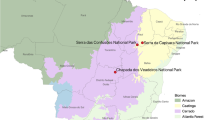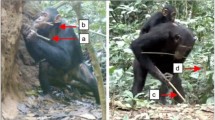Abstract
Contemporary optimization models suggest that animals optimize benefits of foraging and minimize its costs. For wild bearded capuchins (Sapajus libidinosus), nut-cracking entails cost related to lifting the heavy stone and striking the nut and additional cost to transport the stone if it is not already on the anvil. To assess the role of stone mass and transport distance in capuchins’ tool selection, we carried out three field experiments. In Experiment 1, we investigated whether transport distance affected choice of a tool by positioning two stones of the same mass close and far from the anvil. Capuchins consistently selected the closer stone, effectively reducing transport costs. In Experiment 2, we examined the trade-off between the cost of transport and the effectiveness in cracking by positioning two stones of different mass close and far from the anvil. Most subjects significantly preferred the closer stone, regardless of mass, whereas others preferred the heavier stone regardless of transport distance. In Experiment 3, we changed transport distance of both stones while maintaining the same distance ratios as in Experiment 2. Capuchins maintained the preferences expressed in Experiment 2, with the exception of one subject. Overall, our findings indicate that (1) individuals vary in their sensitivity to distance of transport, (2) a few meters are perceived as a substantive cost by some monkeys, and (3) monkeys’ body mass affects their decisions. We also developed a non-dimensional Preference index (P) defined as a function of the stone mass and the transport distance to describe monkey’s choice.




Similar content being viewed by others
Notes
Recent molecular analysis has revealed that capuchin monkeys, formerly identified as the single genus Cebus, are two genera, with the robust forms (including libidinosus, xanthosternos, and several other species) now recognized as the genus Sapajus, and the gracile forms retained as the genus Cebus (Lynch Alfaro et al. 2011, 2012). To date, tool use has been observed in some species of wild Sapajus, but no species of wild Cebus. We retain the genus designation of Cebus for published works cited here that used that designation.
References
Alfaro JWL, Matthews L, Boyette AH, Macfarlan SJ, Phillips KA, Falótico T, Ottoni E, Verderane M, Izar P, Schulte M, Melin A, Fedigan L, Janson C, Alfaro ME (2011) Anointing variation across wild capuchin populations: a review of material preferences, bout frequency and anointing sociality in Cebus and Sapajus. Am J Primatol 73:1–16
Alfaro JWL, Silva JDSE, Rylands AB (2012) How different are robust and gracile capuchin monkeys? An argument for the use of Sapajus and Cebus. Am J Primatol 74:273–286
Altmann SA (1998) Foraging for survival: yearling baboons in Africa. University of Chicago Press, Chicago
Boesch C, Boesch H (1984) Mental map in wild chimpanzees: an analysis of hammer transports for nut cracking. Primates 25:160–170
Charnov EL (1976) Optimal foraging, the marginal value theorem. Theor Pop Biol 9:129–136
Duarte M, Hanna J, Sanches E, Liu Q, Fragaszy D (accepted) Kinematics of bipedal locomotion while carrying a load in the arms in bearded capuchin monkeys (Cebus libidinosus) and humans (Homo sapiens). J Hum Evol
Fragaszy DM, Greenberg R, Visalberghi E, Ottoni EB, Izar P, Liu Q (2010a) How wild bearded capuchin monkeys select stones and nuts to minimize the number of strikes per nut cracked. Anim Behav 80:205–214
Fragaszy D, Pickering T, Liu Q, Izar P, Ottoni E, Visalberghi E (2010b) Bearded capuchin monkeys’ and a human’s efficiency at cracking palm nuts with stone tools: field experiments. Anim Behav 79:321–332
Gerber L, Reichman O, Roughgarden J (2004) Food hoarding: future value in optimal foraging decisions. Ecol Model 175:77–85
Liu Q (2012) The selection and adaptive use of materials in nut-cracking by wild bearded capuchins (Cebus libidinosus): a perception-action perspective. Dissertation, University of Georgia
Liu Q, Simpson K, Izar P, Ottoni E, Visalberghi E, Fragaszy D (2009) Kinematics and energetics of nut-cracking in wild capuchin monkeys (Cebus libidinosus) in Piauí, Brazil. Am J Phys Anthropol 138:210–220
Liu Q, Fragaszy D, Wright B, Wright K, Izar P, Visalberghi E (2011) Wild bearded capuchin monkeys (Cebus libidinosus) place nuts in anvils selectively. Anim Behav 81:297–305
Siegel S (1956) Nonparametric statistics for the behavioral sciences. McGraw-Hill Book Company Inc., New York
Spagnoletti N, Visalberghi E, Ottoni E, Izar P, Fragaszy D (2011) Stone tool use by adult wild bearded capuchin monkeys (Cebus libidinosus). Frequency, efficiency and tool selectivity. J Hum Evol 61:97–107
Stephens DW, Krebs JR (1986) Foraging theory. Princeton University Press, Princeton
Verdolin JL (2006) Meta-analysis of foraging and predation risk trade-offs in terrestrial systems. Behav Ecol Sociobiol 60:457–464
Visalberghi E, Fragaszy D, Ottoni E, Izar P, De Oliveira M, Andrade FRD (2007) Characteristics of hammer stones and anvils used by wild bearded capuchin monkeys (Cebus libidinosus) to crack open palm nuts. Am J Phys Anthropol 132:426–444
Visalberghi E, Sabbatini G, Spagnoletti N, Andrade FRD, Ottoni E, Izar P, Fragaszy D (2008) Physical properties of palm fruits processed with tools by wild bearded capuchins (Cebus libidinosus). Am J Primatol 70:884–891
Visalberghi E, Addessi E, Truppa V, Spagnoletti N, Ottoni E, Izar P, Fragaszy D (2009a) Selection of effective stone tools by wild bearded capuchin monkeys. Curr Biol 19:213–217
Visalberghi E, Spagnoletti N, Ramos da Silva ED, Andrade FRD, Ottoni E, Izar P, Fragaszy D (2009b) Distribution of potential suitable hammers and transport of hammer tools and nuts by wild capuchin monkeys. Primates 50:95–104
Weber E (1978) The sense of touch (Ed and trans: Ross HE). Academic Press (Original work published 1834), London
Acknowledgments
Thanks to the Familia M for permission to work at Fazenda Boa Vista, Noemi Spagnoletti, Giulio Casali, and Alessandro Albani for their assistance in data collection. Thanks to Elsa Addessi for revising the manuscript and to the anonymous referees for their constructive comments. This study was supported by the Leakey Foundation, Sapienza University of Rome, the University of Georgia LACSI Tinker Graduate Research Award, Consiglio Nazionale delle Ricerche Short Term Mobility Program. Permission to work in Brazil was granted by IBAMA and CNPq.
Author information
Authors and Affiliations
Corresponding author
Rights and permissions
About this article
Cite this article
Massaro, L., Liu, Q., Visalberghi, E. et al. Wild bearded capuchin (Sapajus libidinosus) select hammer tools on the basis of both stone mass and distance from the anvil. Anim Cogn 15, 1065–1074 (2012). https://doi.org/10.1007/s10071-012-0530-x
Received:
Revised:
Accepted:
Published:
Issue Date:
DOI: https://doi.org/10.1007/s10071-012-0530-x




